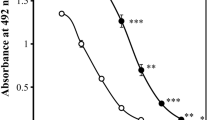Abstract
Water-soluble components of a nephrotoxic isolate of Penicillium aurantiogriseum have been fractionated by sequential ion-exchange, size-exclusion gel filtration, reverse-phase silica chromatography and HPLC. Nephrotoxicity in the rat was confined to a size-exclusion fraction approximating to 1500 daltons, which also inhibited DNA synthesis in cultured kidney cells. The more sensitive in vitro assay allowed toxicity to be followed to a sub-fraction from gradient-elution HPLC which in further HPLC resolved into a small group of glycopeptides. Recent Yugoslavian P. aurantiogriseum isolates, from a village in which the idiopathic human disease Balkan Nephropathy is hyperendemic, elicited a similar nephropathology and were acutely cytotoxic, reinforcing a need to regard this novel Penicillium nephrotoxin as a potential factor in human nephropathy.
Similar content being viewed by others
References
Krogh P. Mycotoxic Nephropathy. In: Wyllie TD, Morehouse LG, eds. Mycotoxic fungi, mycotoxins, mycotoxicoses — An encyclopedic handbook, Vol. 2. New York: Marcel Dekker, 1978.
Hult K, Plestina R, Habazin-Novak V, Radic B, Ceovic S. Ochratoxin A in human blood and Balkan Endemic Nephropathy. Arch Toxicol 1982; 51:313–321.
Pepeljnjnak S, Cvetnic Z. Distribution of moulds on stored grains in households in an area affected by endemic nephropathy in Yugoslavia. Mycopathologia 1984; 86:83–88.
Barnes JM, Carter RL, Peristianis GC, Austwick PKC, Flynn FV, Aldridge WN. Balkan (endemic) nephropathy and a toxin-producing strain of Penicillium verrucosum var. cyclopium: an experimental model in rats. The Lancet 1977; 1:671–675.
Pitt JI. The Genus Penicillium and its teleomorphic states Eupenicillium and Talaromyces. London: Academic Press, 1979.
Calam CT. Culture of microorganisms in liquid culture. In: Norris JR, Ribbons DW, eds. Methods in microbiology 1. London: Academic Press, 1969: 255–326.
Hull RN, Cherry WR, Weaver GW. The origin and characteristics of a pig kidney cell strain, LLC-PK. In vitro 1976; 12:670–677.
Handler JS, Perkins FM, Johnson JP. Studies on renal cell function using cell culture techniques. Am J Physiol 1980; 238:F1-F9.
Peristianis GC, Austwick PKC, Carter RL. An ultrastructural investigation of nephrotoxicity in rats induced by feeding cultures of Penicillium verrucosum var. cyclopium. Vir-chows Arch 1978; 28:321–337.
Schroder E, Lubke K. Homodetic cyclic peptides. In: Schroder E, Lubke L, eds. The peptides, Vol. II. Synthesis, occurrence and action of biologically active polypeptides. New York: Academic Press, 1966: 484–487.
Wellwood JM, Lovell D, Thompson AE, Tighe JR. Renal damage caused by gentamycin: a study of the effects on renal morphology and urinary enzyme excretion. J Pathol 1976; 118:171–182.
Woodward JC, Short DD. Renal toxicity of N-(DL-2-amino-2-carboxyethyl)-L-Lysine (lysinoalanine) in rats. Food Cosmet Toxicol 1977; 15:117–119.
Calne RY, Thiru S, McMaster P, Craddock GN, White DJG, Evans DB, Dunn DC, Pentlow BD, Rolles K. Cyclosporin A in patients receiving allografts from cadaver donors. Lancet 1978; 2:1323–1327.
Ryffel B. Experimental toxicology studies with cyclosporin A. In: White DJG, ed. Cyclosporin A. Proceedings of an International Conference on Cyclosporin A. Amsterdam: Elsevier Biomedical Press, 1982: 46–75.
Munro IC, Moodie CA, Goodman-Kuiper T, Scott PM, Grice HC. Toxicological changes in rats fed graded dietary levels of ochratoxin A. Toxicol Appl Pharmacol 1974; 28:180–188.
Birkinshaw JH, Oxford AE, Raistrick H. Penicillic acid, a metabolic product of Penicillium puberulum Bainer and P. cyclopium Westling. Biochem J 1936; 30:394–411.
Yeulet SE, Mantle PG, Bilton JN, Rzepa HS, Sheppard RN. Auranthine, a new benzodiazepinone metabolite of Penicillium aurantiogriseum. J Chem Soc Perkin Trans I 1986; 1891–1894.
Ganguli M, Burka LT, Harris TM. Structural studies of the mycotoxin verrucosidin. J Org Chem 1984; 49:3762–3766.
Yeulet SE. A penicillium nephrotoxin and associated metabolites in the aetiology of Balkan Nephropathy. Ph.D thesis. University of London, 1986.
Author information
Authors and Affiliations
Rights and permissions
About this article
Cite this article
Yeulet, S.E., Mantle, P.G., Rudge, M.S. et al. Nephrotoxicity of Penicillium aurantiogriseum, a possible factor in the aetiology of Balkan Endemic Nephropathy. Mycopathologia 102, 21–30 (1988). https://doi.org/10.1007/BF00436248
Accepted:
Issue Date:
DOI: https://doi.org/10.1007/BF00436248




